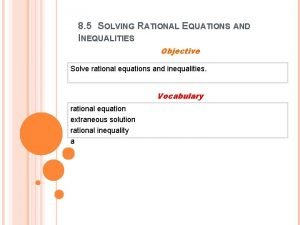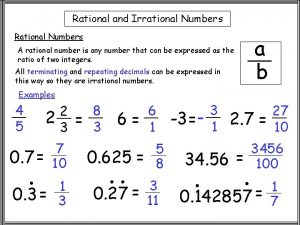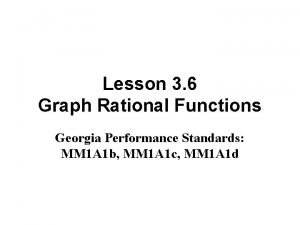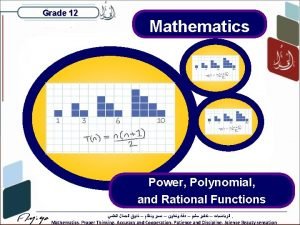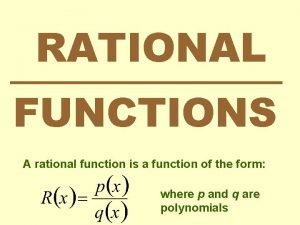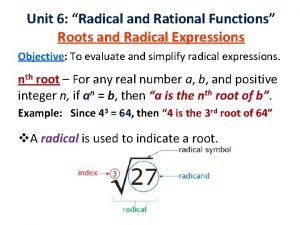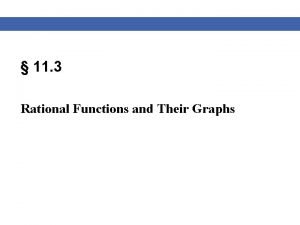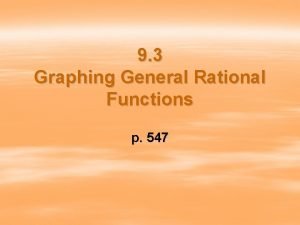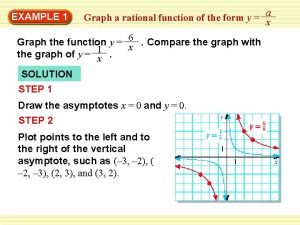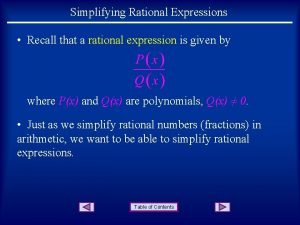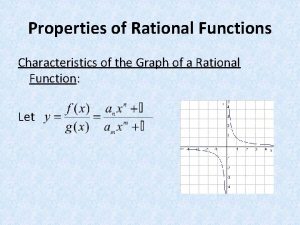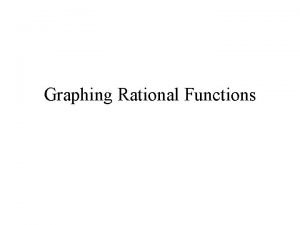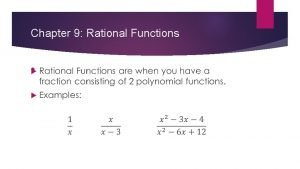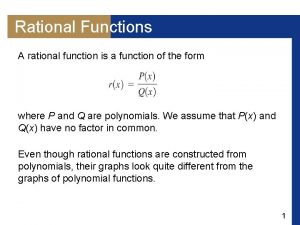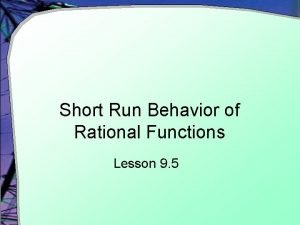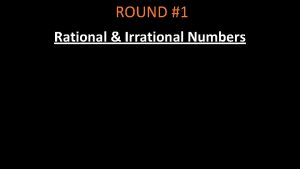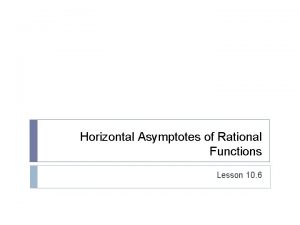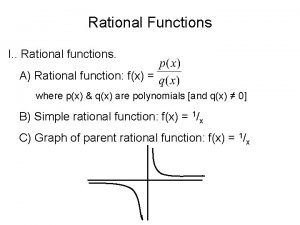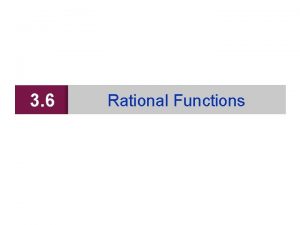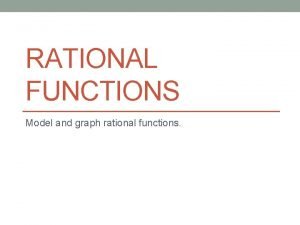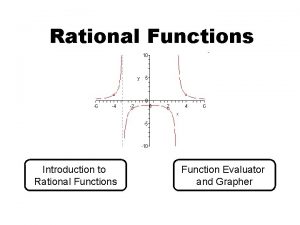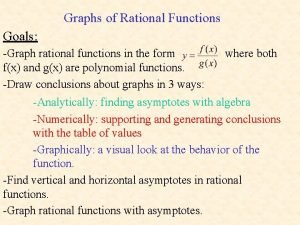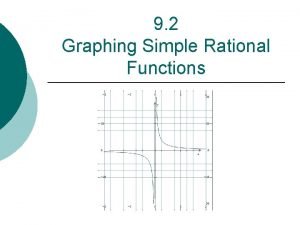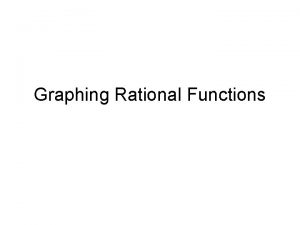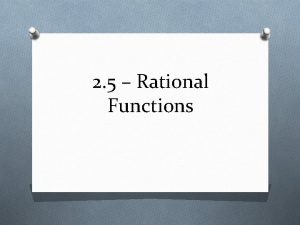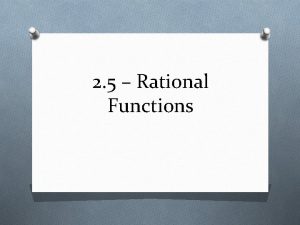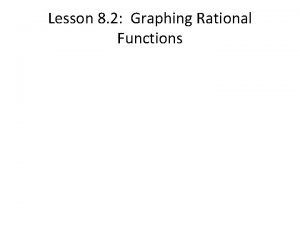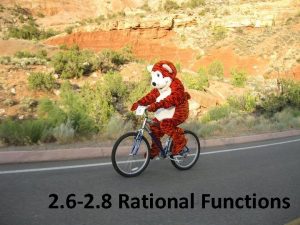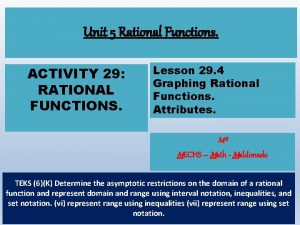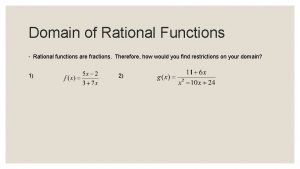3 6 Rational Functions Rational Functions A rational






























- Slides: 30

3. 6 Rational Functions

Rational Functions A rational function is a function of the form where P and Q are polynomials. We assume that P(x) and Q(x) have no factor in common. Even though rational functions are constructed from polynomials, their graphs look quite different from the graphs of polynomial functions. 2

Rational Functions and Asymptotes The domain of a rational function consists of all real numbers x except those for which the denominator is zero. When graphing a rational function, we must pay special attention to the behavior of the graph near those x-values. We begin by graphing a very simple rational function. 3

Example 1 – A Simple Rational Function Graph the rational function f (x) = 1/x, and state the domain and range. 4

Rational Functions and Asymptotes The line x = 0 is called a vertical asymptote of the graph in Figure 1, and the line y = 0 is a horizontal asymptote. Informally speaking, an asymptote of a function is a line to which the graph of the function gets closer and closer as one travels along that line. Figure 1 5

Rational Functions and Asymptotes A rational function has vertical asymptotes where the function is undefined, that is, where the denominator is zero. 6

Transformations of y = 1/x 7

Transformations of y = 1/x A rational function of the form can be graphed by shifting, stretching, and/or reflecting the graph of f (x) = 1/x. 8

Example 2 – Using Transformations to Graph Rational Functions Graph each rational function, and state the domain and range. (a) (b) 9

Asymptotes of Rational Functions To graph more complicated ones, we need to take a closer look at the behavior of a rational function near its vertical and horizontal asymptotes. In general, if r (x) = P(x)/Q(x) and the degrees of P and Q are the same (both n, say), then dividing both numerator and denominator by xn shows that the horizontal asymptote is 10

Asymptotes of Rational Functions The following box summarizes the procedure for finding asymptotes. 11

Example 3 – Asymptotes of a Rational Function Find the vertical and horizontal asymptotes of 12

Graphing Rational Functions We have seen that asymptotes are important when graphing rational functions. In general, we use the following guidelines to graph rational functions. 13

Example 4 – Graphing a Rational Function Graph , and state the domain and range. 14

Common Factors in Numerator and Denominator We have adopted the convention that the numerator and denominator of a rational function have no factor in common. If s(x) = p(x)/q(x) and if p and q do have a factor in common, then we may cancel that factor, but only for those values of x for which that factor is not zero (because division by zero is not defined). Since s is not defined at those values of x, its graph has a “hole” at those points. 15

Example 5 – Common Factor in Numerator and Denominator Graph the following functions. (a) (b) 16

Slant Asymptotes and End Behavior If r (x) = P(x)/Q(x) is a rational function in which the degree of the numerator is one more than the degree of the denominator, we can use the Division Algorithm to express the function in the form r (x) = ax + b + where the degree of R is less than the degree of Q and a 0. This means that as x , R(x)/Q(x) 0, so for large values of | x | the graph of y = r (x) approaches the graph of the line y = ax + b. In this situation we say that y = ax + b is a slant asymptote, or an oblique asymptote. 17

Example 6 – A Rational Function with a Slant Asymptote Graph the rational function . 18

Applications Rational functions occur frequently in scientific applications of algebra. In the next example we analyze the graph of a function from theory of electricity. 19

Example 7 – Electrical Resistance When two resistors with resistances R 1 and R 2 are connected in parallel, their combined resistance R is given by the formula Suppose that a fixed 8 -ohm resistor is connected in parallel with a variable resistor, as shown in Figure 13 20

Example 7 – Electrical Resistance cont’d If the resistance of the variable resistor is denoted by x, then the combined resistance R is a function of x. Graph R, and give a physical interpretation of the graph. 21

3. 7 Polynomial and Rational Inequalities 22

Polynomial Inequalities An important consequence of the Intermediate Value Theorem is that the values of a polynomial function P do not change sign between successive zeros. In other words, the values of P between successive zeros are either all positive or all negative. Graphically, this means that between successive x-intercepts, the graph of P is entirely above or entirely below the x-axis. 23

Polynomial Inequalities Figure 1 illustrates this property of polynomials. This property of polynomials allows us to solve polynomial inequalities like P(x) 0 by finding the zeros of the polynomial and using test points between successive zeros to determine the intervals that satisfy the inequality. P(x) > 0 or P(x) < 0 for x between successive zeros of P Figure 1 24

Polynomial Inequalities We use the following guidelines. 25

Example 1 – Solving a Polynomial Inequality Solve the inequality 2 x 3 + x 2 + 6 13 x. 26

Rational Inequalities Unlike polynomial functions, rational functions are not necessarily continuous. The vertical asymptotes of a rational function r break up the graph into separate “branches. ” So the intervals on which r does not change sign are determined by the vertical asymptotes as well as the zeros of r. This is the reason for the following definition: If r(x) = P(x)/Q(x) is a rational function, the cut points of r are the values of x at which either P(x) = 0 or Q(x) = 0. 27

Rational Inequalities In other words, the cut points of r are the zeros of the numerator and the zeros of the denominator (see Figure 4). So to solve a rational inequality like r(x) 0, we use test points between successive cut points to determine the intervals that satisfy the inequality. r(x) > 0 or r(x) < 0 for x between successive cut points of r Figure 4 28

Rational Inequalities We use the following guidelines. 29

Example 2 – Solving a Rational Inequality Solve the inequality 30
 Solving rational equations and inequalities
Solving rational equations and inequalities Rational robot ibm rational supports which os
Rational robot ibm rational supports which os Gina wilson rational functions
Gina wilson rational functions What is rational and irrational numbers
What is rational and irrational numbers Lesson 3 rational functions and their graphs
Lesson 3 rational functions and their graphs Rational functions grade 12
Rational functions grade 12 What is a rational function
What is a rational function Radical and rational functions
Radical and rational functions Sketch the graph of the following rational function
Sketch the graph of the following rational function Domain and range of rational function
Domain and range of rational function What are the vertical and horizontal asymptotes of
What are the vertical and horizontal asymptotes of Chapter 3 polynomial and rational functions
Chapter 3 polynomial and rational functions Asymptote equation
Asymptote equation Simplifying rational functions
Simplifying rational functions Radical functions and rational exponents
Radical functions and rational exponents Asymptote rules
Asymptote rules What are the properties of rational function?
What are the properties of rational function? Rational functions in the real world
Rational functions in the real world Rational expressions and functions
Rational expressions and functions How to find end behavior of a function
How to find end behavior of a function Rational functions grapher
Rational functions grapher Graph rational functions
Graph rational functions Inverse of rational functions
Inverse of rational functions Rational function examples with answers
Rational function examples with answers Short run behavior of rational functions
Short run behavior of rational functions Unit 6 test radical functions
Unit 6 test radical functions Rational functions parent function
Rational functions parent function Horizontal domain
Horizontal domain Is 43 rational or irrational
Is 43 rational or irrational Rational functions holes and asymptotes
Rational functions holes and asymptotes Rational functions and their graphs
Rational functions and their graphs
